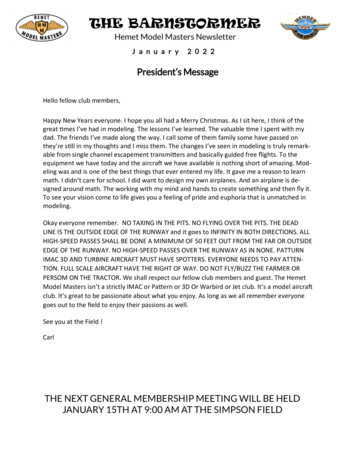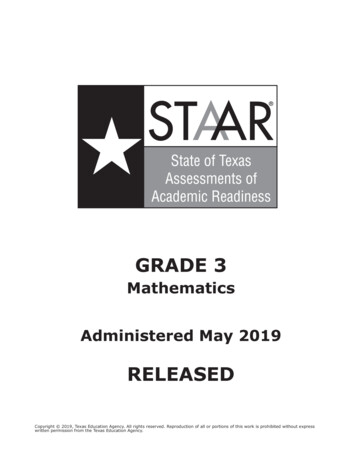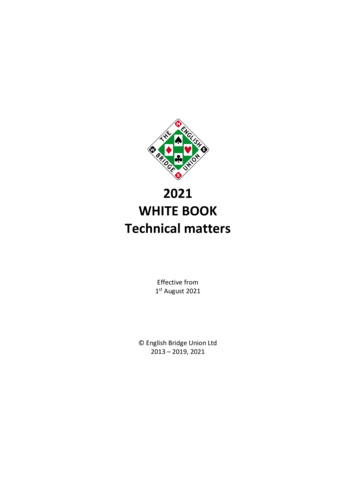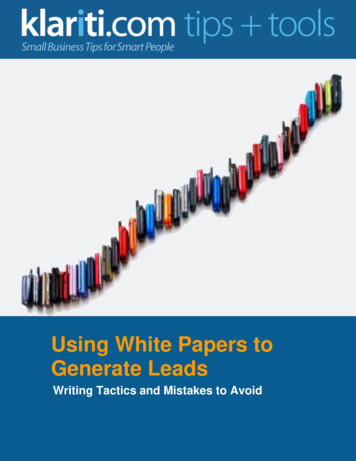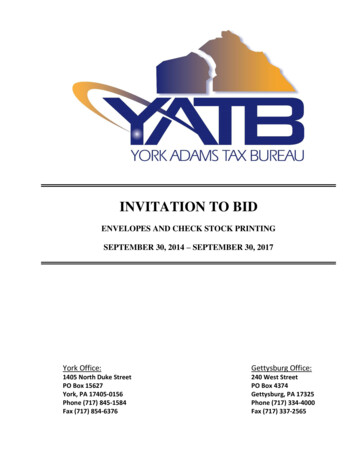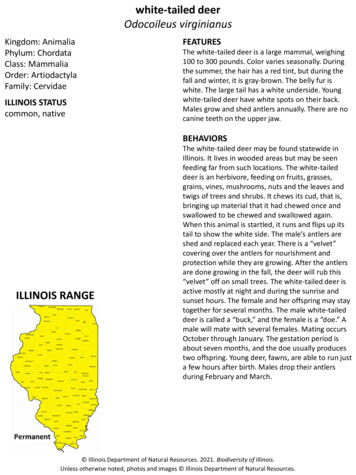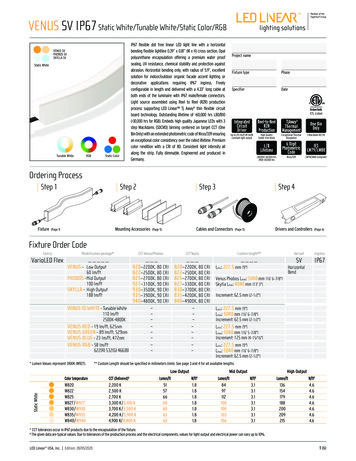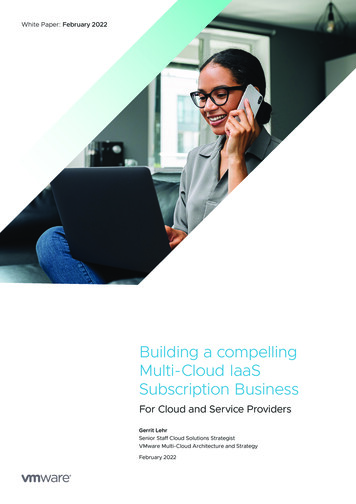
Transcription
White Paper: February 2022Building a compellingMulti-Cloud IaaSSubscription BusinessFor Cloud and Service ProvidersGerrit LehrSenior Staff Cloud Solutions StrategistVMware Multi-Cloud Architecture and StrategyFebruary 2022
Building a compelling Multi-Cloud IaaS Subscription BusinessTable of contentsExecutive Summary.3Example Partner Profile.3The Multi-Cloud Business Model.4Hyperscale Public Cloud: Friend or Foe4Business Model Overview5Economics of VCPP Rental vs. Managed Service Provider SaaS6The right Metrics for Subscription and Growth8Multi-Cloud Services for VMware Cloud Providers.9Operational Improvement with Cloud Partner Navigator9Global IaaS Expansion with VMware Hyperscale Solutions10Multi-Cloud Business Case.12VMware Cloud Cost and Scale Assumptions12Additional MSP Services and Key Use-Cases13MSP Discount Structure14TCO Comparison14Subscription Business Model Optimization16Subscription Business Growth vs. Profitability18Conclusion.19List of Figures.20Appendix 1: TCO Model Parameters.21White Paper 2
Building a compelling Multi-Cloud IaaS Subscription BusinessCloud Provider Profile 7,000 – 10,000 VMs 8.7 Million USD Revenue 30% Margin Global Presence Value-Add Differentiation Full Automation and ScalabilityMulti-Cloud ServicesMulti-Cloud Infrastructure,Secure Multi-Tenancy,Consumption and OperationsMulti-Cloud Workload Migrationand MobilityMulti-Cloud Container-as-aService and Native Cloud ServiceExecutive SummaryVMware Cloud partners seek to deliver unique value through regional datacenters, compliance with local regulations, language and currency support, aswell as value-add managed services. In a multi-cloud world, however,customers also require global availability and additional services and scalethat is typically only found in hyperscale public cloud portfolios. This whitepaper builds on the Cloud Provider Total Cost of Ownership (TCO) model forIaaS1 and Modern Application2 offerings, which are detailed in two previouslypublished papers. TCO provides an essential element to generate rich marginsfrom cloud services and can have a critical impact on a VMware CloudProvider’s profit.In this third paper of the series, we focus on multi-cloud use-cases,subscription business models and solutions, which can be enabled throughthe VMware Partner Connect Cloud Provider and Managed Service Providermodels. The approach we describe is intended as a guide for partners to offernew services on a proven platform that is innovative and competitively priced.While the first two white papers put strong focus on price competitivenessand TCO, this paper also looks at financial metrics for subscription businesses,incremental growth and value delivered through multi-cloud offerings incooperation with hyperscale public clouds. It puts emphasis on financials andeconomics of an operational expenditure (OpEx) and Software-as-a-Service(SaaS) strategy, versus a capital investment (CapEx), asset-heavy strategy withrental software models.We will detail a portfolio of services and solutions that we believe can allowpartners to address a wide range of multi-cloud use-cases and significantlyincrease their competitive appeal with customers. Based on the examplecalculations used in this paper, we show that building an IaaS business onhyperscale public cloud services can lead to rapid growth, instant positivecash flow and generate margins of up to 30 percent, even on a globallydistributed cloud platform. Please note, however, that each provider’scircumstances are unique and that the guidance contained in this white paperdoes not guarantee a successful outcome or any particular outcome.The information delivered in this paper comes directly from the VMware MultiCloud Architecture and Strategy team, a VMware organization that supportsand enables cloud providers around the globe with strategy and architectureconsulting services. They deliver hundreds of workshops and engagementsannually, including detailed strategy and roadmap development, servicedesign, differentiation, business case analysis and TCO models for partners.Example Partner ProfileLike the first two white paper of this series, the assumptions used in thisanalysis are based on data and insights from real-world providers and theVMware Multi-Cloud Architecture and Strategy team’s experience fromworking with all kinds and sizes of cloud providers around the world.1. Building a compelling Cloud Platform TCO on the VMware Cloud Provider Platform: https://www.vmware.com/learn/585731 REG.html2. Building a compelling Modern Apps and Managed Application Cloud Provider Business: 0.pdfWhite Paper 3
Building a compelling Multi-Cloud IaaS Subscription BusinessBuilding a compelling CloudProvider Business – WhitePaper Series:Part 1: Building a compelling CloudPlatform TCO on the VMware CloudProvider PlatformPart 2: Building a compellingModern Apps and ManagedApplication Cloud ProviderBusinessPart 3: Building a compelling MultiCloud IaaS Subscription BusinessYou are hereThis white paper uses a hypothetical VMware Cloud Provider partner called“ACME Cloud”, which comes from an infrastructure hosting business limitedto one region. ACME Cloud wants to significantly increase revenue from 3.3 toabove 8.7 million USD annually by pursuing two strategic objectives: first,offer a very competitive platform for commodity and price sensitiveworkloads, which is already in place1; and second, add standardized andscalable cloud migration, global data center expansion and applicationmodernization services.Achieving this goal requires a range of improvements in ACME Cloud’spractice and operations including, for example, an expansion away from asingle datacenter region to an eventual global presence of locations to fulfillthe offered services, as well as the associated migration, workload mobilityand application modernization capabilities.Overall, ACME Cloud anticipates running more than 7,000 VMs on its regionalIaaS platform plus an additional 3,000 VMs from global expansion over athree-year business term. A critical component to financing the growthstrategy is to achieve the target margin profile of at least 30 percent, whichcan only be achieved through higher value-added services and the rightcombination of skilled people, innovative partners, efficient processes as wellas standardized and automated tools. Cloud provider businesses rely on IaaSas the foundation for successful value-added and higher abstraction services.The Multi-Cloud Business ModelHyperscale Public Cloud: Friend or FoeFor most VMware CloudProviders, coopetition isbecoming the commonrelationship towards hyperscalepublic cloud providers.Over the last five years, strategic discussions with VMware Cloud Providerpartners sooner or later focused on the role of hyperscale public cloudproviders and their impact on a provider’s strategy. These hyperscale publicclouds have rapidly expanded in scale, service scope and regional availabilityup to a point today, where they are a constant and significant part of anycustomer IT strategy. The term hyperscale or hyperscaler is usuallyunderstood to encompass at least the three largest providers Amazon WebService (AWS), Microsoft Azure and Google Cloud Platform (GCP), as well asadditional global providers like IBM Cloud, Oracle Cloud and Alibaba Cloud,or others. They all share similar characteristics, among others globalavailability, a broad range of services beyond infrastructure and madeconsumable via a comprehensive API, as well as a partner channel model.While the first set of these characteristics is usually considered potentialthreats to regional VMware Cloud Provider partners, the last one, using apartner channel model, must be considered an opportunity from a strategicperspective.The threat of these hyperscale public clouds entering any given regionalmarket puts them in a competitive position to any existing partner. In manyinstances, this competition is based on a cost advantage through extensiveeconomies of scale as well as portfolio breadth difficult to match for anyexisting provider in the market. Yet the authors believe, as we have argued inthe previous white papers, that VMware Cloud Providers can effectivelyaddress this competitive threat by matching hyperscale public cloud costs forraw service infrastructure and pricing through scalable software-definedWhite Paper 4
Building a compelling Multi-Cloud IaaS Subscription Businessplatforms and operations. And they can focus on differentiation through understanding customer needs, data sovereigntyand high-profit managed and professional services that are not available from hyperscale public clouds.Whichever competitive strategy is chosen, hyperscale public cloud provider channel partner models also offer an importantopportunity for VMware Cloud Provider partners. They provide access to geographic regions that are hardly addressablevia internal resources, offer access to a new portfolio of services and allow the expansion of a VMware Cloud Provider’svalue-added services business based on the familiar VMware software stack. This situation leads to so-called coopetition.Coopetition describes the duality of competition and cooperation between two market actors and for most VMware CloudProviders today, it is becoming a very common relationship towards hyperscale public cloud providers.While earlier strategic discussions with providers often focused on how to compete with the new entrants by relying onexisting business conditions and models, we are now seeing a strategic shift in most regions towards an expansion of theestablished business model that builds on the opportunities offered from hyperscale public cloud provider cooperation. Asimilar shift in strategic direction happened for our example provider ACME Cloud when considering options to achieveglobal expansion while maintaining a manageable risk profile and price competitiveness.Business Model OverviewNow that the coopetitive nature of the relationship with hyperscale public cloud has been broached, ACME Cloud needs todefine the business model to focus on in the multi-cloud market which opened through the option of cooperation withhyperscale public clouds. ACME Cloud, like many VMware Cloud Provider partners, aims to provide a smooth path to valuefrom multi-cloud for its customers along some key use-cases:Use Case:Global Multi-Cloud ConsumptionUse-Case:Cloud Migration and MobilityUse-Case:Application ModernizationCustomers need to be able to consumethe best cloud platform for any givenworkload.Customers need a cost-effective way formoving workloads into the cloud andback out again when required.Customers need to leverage higherabstraction services to modernize theirapplication portfolio on any cloud.VMware Cloud Providers offer multicloud services that allow access tomultiple cloud platforms across variouslocations globally and enable seamlessconsumption of resources.(VMware Cloud)VMware Cloud Providers offer aconsistent layer across multiple cloudplatforms and the relevant migration andmobility tools to easily move workloadsbetween clouds.(VMware Cloud and HCX)VMware Cloud Providers offer multiplecloud destinations with adjacency to awide portfolio of modern applicationservices as well as Kubernetes anddeveloper tools.(VMware Cloud and Tanzu)Figure 1: Common Provider Multi-Cloud Use-CasesTo enable these use-cases, providers in general can build their multi-cloud business on specific partner contracts withVMware and hyperscale public clouds such as the VMware Managed Service Provider model3, AWS Managed ServiceProvider Partner program4, Microsoft Cloud Solution Provider program5 or the Google Cloud Partner Advantage program6.These programs are structured in very similar ways and, in the case of the VMware MSP model, have the followingcharacteristics: The VMware Cloud Provider partner owns the End-to-End customer relationship. The VMware Cloud Provider partner sells services under its own terms of service. The VMware Cloud Provider partner provides primary support for the offered services. The VMware Cloud Provider partner handles metering and billing towards its customers.3. VMware Managed Service Providers: anaged-services.html4. AWS Managed Service Provider (MSP) Program: https://aws.amazon.com/partners/programs/msp/5. Microsoft Cloud Solution Provider Program: ution-provider6. Google Cloud Partner Advantage: White Paper 5
Building a compelling Multi-Cloud IaaS Subscription BusinessBy utilizing multiple programs and the wide range of services that are available through them in the right combination,partners can create two main service models: first, they can manage provisioning, billing and support across hybrid andmulti-cloud environments for their customers as a single point of contact. This by itself provides a large opportunity forvalue-added services like lifecycle management, monitoring, cost optimization, migration and more; and second, they canbuild and support more complex solutions and applications that span different clouds, including hyperscale public clouds,established on-premises partner or customer clouds and customer edge-clouds, and offer them as a single, closed serviceunder their own terms to their customers.Multi-Cloud ServicesCloud SEARCHAPPFUNCTIONSGCVEGCEBIG QUERYCLOUD SQLDNSAPP zeMSPAdd-OnServicesMigrationctSPCoct.MSAWactontrSP MSP Partner providesmanaged service andhandles relationship,T&C, pricing, billing,and supportvRealizerantTCMSFGCPCustomers consumemanaged service orapplication acrossdifferent cloudsTANZUraVMwaServiceContractbetweenMSP &CustomerCDSntCoMSPPartnercontractbetweenMSP &customerreAlternativeAdditional EnterpriseAgreement betweencustomer and tionCostingMonitoringFigure 2: Multi-Cloud Business Model for VMware Cloud Providers and MSPs.Economics of VCPP Rental vs. Managed Service Provider SaaSVMware offers two main routes for cloud provider partners to deliver services. To build cloud services in their datacentersand on hardware owned by them, VMware Cloud Provider partners can leverage the VCPP rental model, like ACME Clouddid in the past to build IaaS and modern application services. These providers install VMware software on theirinfrastructure to build and offer their own cloud and get charged based by VMware on actual consumption by their endcustomers. Operating and managing these ACME Cloud provider-owned clouds remains their own responsibility and thecore of their business to serve regional workloads.The second route is the VMware Managed Service Provider (MSP) model. It allows VMware Cloud Provider partners toaccess and consume VMware-operated cloud services and provide managed services on top, without worrying aboutoperating and managing the underlying infrastructure or service. This route allows ACME Cloud to put more focus on valueadded services and differentiation, instead of infrastructure and datacenter operations. And the MSP model gives ACMECloud and all other Managed Service Provider partners access to services and global locations, with rapid scale andimmediate availability that would otherwise be extremely expensive and likely unprofitable to obtain. With regards tooffering a core portfolio of multi-cloud services that support ACME cloud’s target customer use-cases, MSP partners have awide choice of VMware rental or SaaS options.White Paper 6
Building a compelling Multi-Cloud IaaS Subscription BusinessService OfferingVCPP Rental SolutionMSP SaaS SolutionPrivate / Dedicated IaaS CloudVMware Cloud Foundation (VCF)VMware Cloud (VMC)Edge Cloud / Cloud-to-GroundVMware Cloud Foundation (VCF)VMware Cloud on Dell EMC (VMC-D)Public / Shared Multi-Tenant CloudVMware Cloud Director (VCD)VMware Cloud Director Service (CDS)Multi-Cloud OperationsVMware vRealize Operations (vROps)VMware vRealize Operations CloudMulti-Cloud LoggingVMware vRealize Log Insight (vRLI)VMware vRealize Log Insight CloudMulti-Cloud Network OperationsVMware vRealize Network Insight (vRNI)VMware vRealize Network Insight CloudMulti-Cloud AutomationVMware vRealize Automation (vRA)VMware vRealize Automation CloudWorkload Mobility and MigrationVMware Hybrid Cloud Extension (HCX)VMware Hybrid Cloud Extension (HCX)Figure 3: VCPP and MSP Solution OverviewThe most successful VMware partners build their business on a combination of both, the VCPP rental and MSP model. Todecide between VCPP rental and MSP SaaS solutions specifically for the multi-cloud business on a solid financial basis,ACME Cloud needs to first understand and consider the economics between both alternatives. Let’s start with the VCPPrental model, which is already used in ACME Cloud’s existing IaaS offerings and will remain so for this part of the business.Financially, the VCPP rental model is investment and capital expenditure (CapEx) driven or “asset-heavy” regardingphysical resources. While the VMware software portion in VCPP is charged as a flexible rental charge, the model stillrequires the partner to procure, capitalize and depreciate physical assets such as data center facilities, physical servers,network and storage systems and all adjacent assets to build the environment. From an operational expenditure (OpEx)perspective, operating and maintaining the environment will typically result in fixed labor costs for staff. Given that VCPP isa rental model, VMware software licenses also fall into the OpEx bucket. The remaining CapEx from hardware in assetheavy models cause a high initial negative cash flow and recurring depreciation expenses across the lifecycle of the assets.This is also the main difference to the MSP SaaS alternatives. Let’s look at a hypothetical example calculation for a VCF andVCD-based rental IaaS platform to illustrate the development in figure 4.VMware Cloud Director (On-Premises with VCF)Cumulative Monthly Revenue, Cost & MarginLinear Ramp: 7,000 VMs over 36 Months40% 900,000 800,00020%Cash Flow Positive:Month 27 700,000 600,0000% 500,000-20% 400,000-40% 300,000 200,000-60% 100,000-80%- -1000,000-100%110CostMargin20Margin30 monthsRevenueMargin (%)Figure 4: VCPP Rental Cashflow with VCF and VCDWhite Paper 7
Building a compelling Multi-Cloud IaaS Subscription BusinessIn the example calculation in figure 4, there is a positive cash flow in month 27 due to high initial outflow of cash forpurchasing the required hardware upfront and implementing the cloud environment. For providers and investors that arefocused on optimizing traditional financial KPIs like Return on Investment (ROI) and Earnings before Interest, Taxes,Depreciation and Amortization (EBITDA), the asset-heavy approach may, however, still be very attractive since it allows theoptimization of profit margins over time as the business scales and assets become optimally utilized.VMware Cloud Director service (VMC on AWS)Cumulative Monthly Revenue, Cost & MarginLinear Ramp: 7,000 VMs over 36 Months 900,00040% 800,00020% 700,0000% 600,000 500,000-20% 400,000 300,000Cash Flow Positive:Month 1-40% 200,000-60% 100,000- -80%110CostMargin20Revenue30 monthsMargin (%)Figure 5: MSP SaaS Cashflow with VMC and CDSIn the MSP SaaS or “asset-light” model, everything from hardware to software to operations is included in the MSP price asan OpEx charge. This first means that the partner does not need to deal with sizing and procuring the right amount ofinfrastructure, including burst and failover capacity, and depreciating it. And from a cash flow perspective, it also meansthat the entire stack of components needed for any given service is aligned between the cost and revenue part of theequation. Partners get charged and pay on a monthly or annual basis, based on the consumed services and charge theircustomers respectively. This frees them from large initial investments and negative cash flow from their own infrastructureassets. And since larger parts of the base service operation are included in the variable SaaS OpEx, fixed costs for staff canbe directed to adding and differentiating tasks and services.The right Metrics for Subscription and GrowthAt this stage of the process, ACME Cloud needed to consider the impact of both models in their financial metrics – andchoose the right metrics to begin with. This discussion requires the accounting and finance executives to understand theongoing change to a SaaS-based world and subscription economies, and in the case of ACME Cloud goes all the way up tothe CFO.For VMware Cloud Providers in general, the financial implications of moving to a SaaS and subscription model are very wellunderstood on the revenue side. The revenue from Cloud subscription services occurs over an extended time period in arecurring way, instead of via one large upfront deal. The better the service, the longer the customer consumes, the higherthe revenue and profits across the customer lifetime. The key metrics here are any form of recurring revenue, for exampleannual recurring revenue (ARR) or monthly recurring revenue (MRR). Marginal costs to provide the service to customersover a longer period are close to zero, yet upfront costs to stand up the environment in an asset-heavy model and onboardcustomers are still high, requiring recurring revenue streams over a sustained period for recovery. However, a dissatisfiedcustomer may leave the provider and stop contributing to revenue and margins before they contribute sufficiently torecover upfront costs, which is a risk and can negatively impact the customer lifetime value (LTV).To address this risk, the cost side of the business must be reconsidered to focus on metrics that are the most meaningful ina subscription economy. As a SaaS consumer in the VMware MSP model, VMware Cloud Providers building on a partiallyasset-light model can enjoy similar benefits as their subscription customers. In an asset-heavy sales business, key metricsare usually ROI and EBITDA, both describing the financial performance of assets and investments. These metrics arenegatively impacted by high customer churn leading to lower customer lifetime value. Moving to an asset-light SaaS modelWhite Paper 8
Building a compelling Multi-Cloud IaaS Subscription Businesson the supply side can mitigate the negative impact on performance from churn by reducing potentially sunk upfrontinvestments. This shift also makes traditional financial KPIs like ROI and EBITDA less meaningful. Instead, the CustomerAcquisition Costs (CAC) and Time to Recover CAC shift into focus. They express how much money the company needs tospend in order to acquire an average customer as well as the period required to recover these costs. The recovery periodfor CAC is dependent on the margin and the recurring average revenue per customer (ARPC). The shorter the time torecover CAC, the faster the business starts to generate profit. Additionally, these metrics are also meaningful for their abilityto predict growth of a new business in early stages and where profitability metrics like operating profit, ROI and EBITDA arenot yet in focus:CAC Total Costs of Sales and Marketing / # of customers acquiredTime to Recover CAC CAC / (ARPC x % Gross Margin)Customer LifetimeValue (LTV)TimeCustomerAcquisitionCosts (CAC)CustomerAcquisitionBreakevenPointAverage Revenueper Customer (ARPC)AcquisitionTime to Recover CACRetentionReduce CACthrough costoptimizationReduce CAC recoveryperiod, e.g. onboardingfee etc.Increase customer lifetime value through up- and cross-selling. Reducechurn via customer service and experienceChurnFigure 6: Subscription business metrics and relationshipsIn a nutshell, moving to a SaaS-based or asset-light supplier model helps free providers from focusing too much ontraditional KPIs like margin, ROI or EBITDA. The cost structure moves from a CapEx to and OpEx model with lessinvestment. CAC and Time to Recover CAC become more important and have a more direct relationship to growth KPIs likeLTV, ARR/MRR or ARPC. The final important KPI from these insights is the LTV:CAC ratio. It expresses the overall health ofa growing subscription business.Multi-Cloud Services for VMware Cloud ProvidersOperational Improvement with Cloud Partner NavigatorIn their own cloud, built via the VCPP rental model, ACME naturally faces a certain degree of management complexity andoperational overhead managing customer’s workloads and service lifecycles. To scale globally, providers like ACME Cloudneed a unified view of workloads, aggregated and filtered by customers, across all VMware-based clouds and services.They want to deliver a unified, self-service cloud experience to their customers across the global multi-cloud landscape.Without a common management platform or investing in expensive custom tooling, ACME Cloud struggles to simplify cloudand business operations across clouds with common contract management, customer usage, provider billing and support.To address these issues, VMware Cloud Partner Navigator provides a unified SaaS partner platform for VMware Clouds andcloud services. Cloud Partner Navigator enables ACME Cloud to deliver multi-cloud services to customers worldwide andsignificantly simplifies business and customer operations. Cloud Partner Navigator comes at no additional cost to partnersand helps improve ACME’s cloud economics through key capabilities like global business expansion, simplified operationand enhanced customer experience.White Paper 9
Building a compelling Multi-Cloud IaaS Subscription BusinessVMware Cloud Partner NavigatorAny CloudAny ServiceFigure 7: VMware Cloud Partner Navigator for MSPs and Cloud ProvidersGlobal IaaS Expansion with VMware Hyperscale SolutionsThe first core use-case for ACME to address is the global consumption of Infrastructure as a Service from its customers. Thisis the logical extension to ACME Cloud’s existing on-premises IaaS business, which is hosted in ACME-owned datacenterfacilities and allows them to serve customers and their users in geographically dispersed locations with the same quality andportfolio of value-added services. Beyond that, it enables ACME Cloud to enter these new regions and expand the overallcustomer base.To expand the ACME Cloud IaaS footprint in an asset-light way, several major hyperscale public cloud providers offer thewell-known and established VMware SDDC stack in their clouds.7 These clouds include, for example, VMware Cloud onAWS (VMC), Azure VMware Solution (AVS), Google Cloud VMware Engine (GCVE), Oracle Cloud VMware Solution (OCVS),IBM Cloud for VMware Solution or Alibaba Cloud VMware Solution (ACVS) and others. For edge and cloud-to-grounddeployments on customer premises with a truly managed cloud experience, VMware Cloud on Dell EMC expands theVMware Cloud model to these locations.Partner / CustomerOn-PremisesHyperscaleVMware ServiceVPN / DirectvCenterAutomation & OperationsvCenterAutomation & OperationsNSXNSXvSphere Storage NetworkPartner / CustomerDatacenterHyperscaleNative ServicevSpherevSANNSXHyperscale Global InfrastructureFigure 8: VMware Hyperscale Solution on Public Clouds7. VMware Hyperscale Solutions and Partners: /hyperscalers.htmlWhite Paper 10
Building a compelling Multi-Cloud IaaS Subscription BusinessWhile all options provide similar value in terms of rapid availability and scalability, adjacency to the native service portfolioof the respective public cloud provider and the reliable stack of VMware vSphere, NSX and vSAN, there are a couple ofdifferences ACME Cloud had to consider when choosing its partners. In the initial approach, ACME conducted an overviewacross VMC on AWS, AVS and GCVE, representing the three largest hyperscale public clouds. The result is outlined infigure 9.Another important service component that enables a seamless customer experience, secure multi-tenancy and efficientoperations across these VMware Hyperscale solutions, is VMware Cloud Director service (CDS). The VMware CloudDirector service is a container-based SaaS version of the proven VMware Cloud Director on-premises service-deliveryplatform. The service, available through VMware Cloud Partner Navigator, is part of the VMware MSP asset-light model.VMware Cloud on AWSAzure VMware SolutionsGoogle Cloud VMware EngineMin. / Max. SDDCsizeMinimum: 2 NodesMinimum: 3 NodesMinimum: 3 Nodes (first cluster)Maximum: 16 NodesMaximum: 16 NodesMaximum: 32 NodesComponentsincludedvSphere, vCenter, VSAN, NSXHCX Advanced and EnterprisevSphere, vCenter, VSAN, NSXHCX AdvancedvSphere, vCenter, VSAN, NSXHCX AdvancedOptionalAdd-Ons VMware Cloud DisasterRecovery VMware HCX Enterprise VMware HCX Enterprise VMware SRM VMware SRM VMware vRealize Cloud VMware vRealize Cloud Free extended Windows Server/ SQL Server 2008 Support SDDC Autoscaling VMware Site Recovery VMware vRealize CloudKey Features Stretched Cluster Option SDDC Autoscaling (eDRS) Includes VMware TMCEssentials Escalated Privileges Setting Azure Hybrid BenefitsAccessAPI, VMware Cloud PortalAPI, Azure Port
Cloud and all other Managed Service Provider partners access to services and global locations, with rapid scale and . IBM Cloud for VMware Solution or Alibaba Cloud VMware Solution (ACVS) and others. For edge and cloud-to-ground deployments on customer premises with a truly managed cloud experience, VMware Cloud on Dell EMC expands the .


